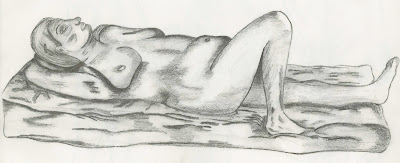Here is a 2 hour Final Life drawing done in pencil. The primary focus in this image is on the posture and pose of a life model. Weight distribution over the soft surface the model is using is also a key feature that is used to help establish light. The proportion is slightly off in areas such as the leg where it seems very elongated compared to the rest; however the surface material helps lower the awareness by questioning the perspective. The tone of the image is to signify where the light is illuminating from. This also connotes the muscle structure of the model and how their body mass effects where tone is established.
The overall body layout is very loose and open allowing for a clear establishment around the model and the different levels of tone. The surface is interesting to place with the model, not just so it doesn't seem as if the model is floating in the air, but it helps build characteristics of the model, showing where weight distributes and how this affects the outcome of the image.
With more time the tones could be slightly improved by allowing more of a flow with in the different levels, to show that if an area is darkened out almost, that it fades into another tonal level close to this rather than just a completely different tone conveying uncertain tone. The shading from the surface material, particularly around areas such as the right foot, also helps to fortify the structure of the model allowing it to look more bold.






















